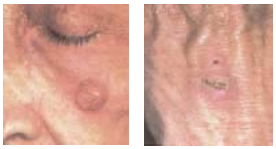Skin cancer is the most common type of human cancer. Its rate has been increasing in recent years, mainly because of the mutation-causing effects of the ultraviolet rays in sunlight.
Malignant melanoma results from an overgrowth of melanocytes, the pigment-producing cells in the epidermis. It is the most dangerous form of skin cancer because of its tendency to metastasize. This cancer appears as a lesion that is variable in color with an irregular border. It may spread superficially for up to 1 or 2 years before it begins to invade the deeper tissues of the skin and to metastasize through blood and lymph. The prognosis for cure is good if the lesion is recognized and removed surgically before it enters this invasive stage.
Squamous cell carcinoma and basal cell carcinoma are both cancers of epithelial cells. Both appear in areas exposed to sunlight, such as the face. Squamous cell carcinoma appears as a painless, firm, red nodule or plaque that may develop surface scales, ulceration, or crusting (Fig. 1). This cancer may invade underlying tissue but tends not to metastasize. It is treated by surgical removal and sometimes with x-irradiation or chemotherapy.

FIGURE 21-6. Squamous cell carcinoma shown on the face and the back of the hand, sun-exposed areas that are commonly affected. (Reprinted with permission from Bickley LS. Bate's Guide to Physical Examination and History Taking. 8th Ed. Philadelphia: Lippincott Williams & Wilkins, 2003.)
Basal cell carcinoma constitutes more than 75% of all skin cancers. It usually appears as a smooth, pearly papule. Because these cancers are easily seen and do not metastasize, the cure rate after excision is greater than 95%.
Kaposi sarcoma, once considered rare, is now seen frequently in association with AIDS. It usually appears as distinct brownish areas on the legs. These plaques become raised and firm as the tumor progresses. In those with weakened immune systems, such as AIDS patients, the cancer can metastasize.
责任编辑:admin
上一篇:医学文章阅读——PRESSURE ULCERS
下一篇:医学文章阅读——Autoimmune Disorders

微信公众号搜索“译员”关注我们,每天为您推送翻译理论和技巧,外语学习及翻译招聘信息。